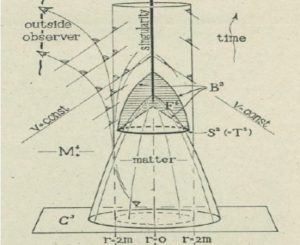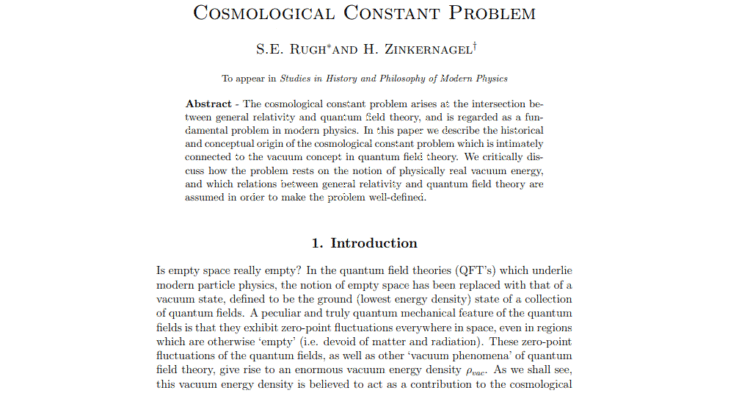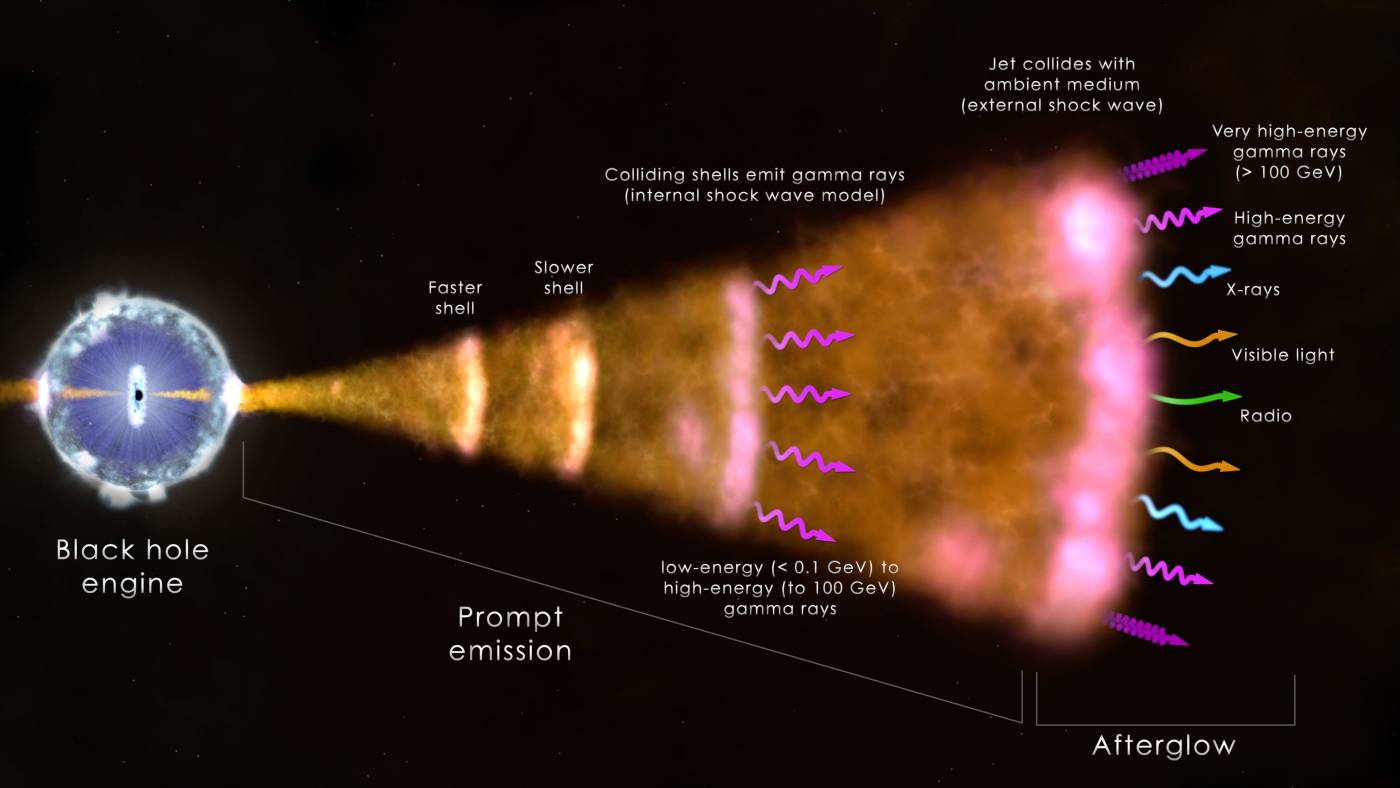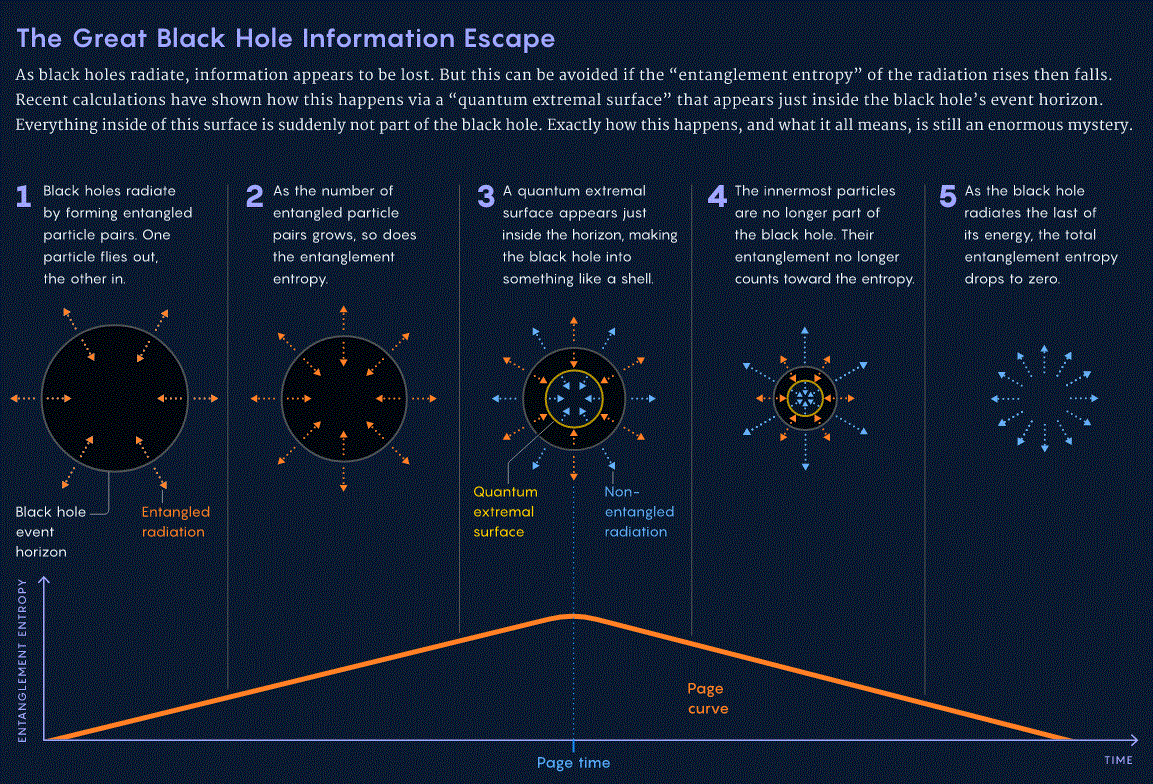When you read the Einstein digital papers, you understand how gravity works. Einstein said things like “the curvature of light rays occurs only in spaces where the speed of light is spatially variable”. Note that he never abandoned this, and he never said light curves because it follows the curvature of spacetime. Instead he said a gravitational field is a place where space is “neither homogeneous nor isotropic”, he referred to Huygen’s principle, and he talked about “the refraction of light rays by the gravitational field”. So did Newton, see Opticks query 20. Also see what Irwin Shapiro said in 1964: “according to the general theory, the speed of a light wave depends on the strength of the gravitational potential along its path”. On top of that take a look at what PhysicsFAQ editor Don Koks said in 2014: “light travels faster near the ceiling than near the floor”. We have hard scientific evidence of that, in that optical clocks go slower when they’re lower. Not because some unseen thing call time goes slower. Because light goes slower:
 Parallel-mirror light clock gif by Brian McPherson
Parallel-mirror light clock gif by Brian McPherson
Don’t overthink it, don’t get distracted by abstraction, be empirical. Remember that we don’t call it gravitational lensing for nothing. Then you can appreciate that light waves curve downwards in space like sonar waves curve downwards in the sea, because the speed of sound decreases with depth. Then you can appreciate that matter falls down because of the wave nature of matter, and because spin is real. See page 26 of Schrödinger’s 1926 paper quantization as a problem of proper values, part II. He said “let us think of a wave group of the nature described above, which in some way gets into a small closed path”. He was talking about the electron. Also see Hans Ohanian’s 1984 paper What is Spin? He said spin could be regarded as a circulating flow of energy. So think gamma-gamma pair production, then simplify the electron to light going round a closed path. Then simplify it further to light going round a square path. Then think what happens if the horizontal components are curving downwards. The electron falls down:

It’s all very simple and straightforward¹, but it does means that there are some misconceptions in gravitational physics. One is that your typical plot of curved spacetime isn’t depicting curvature in some higher dimension. It’s a curvature of your metric, which is derived from your measurements. Think of it as a plot of optical clock rates in a horizontal slice of space around a gravitating body. Plot your clock rates such that the lower slower clock rates generate data points lower down in a 3D image, and the higher faster clock rates generate data points higher up in the 3D image. Then for a black hole you end up with something like this:
 Image from Ethan Siegel’s blog starts with a bang
Image from Ethan Siegel’s blog starts with a bang
Light curves and matter falls down wherever there’s a gradient in the speed of light, which corresponds to the spacetime gradient on your plot. The steeper the gradient, the stronger the force of gravity. The spacetime curvature on the plot is proportional to the tidal force at that location, not the force of gravity. Yes, it’s all very simple, and nicely in line with Oppenheimer and Snyder’s 1939 frozen star paper on continued gravitational contraction. It’s like Remo Ruffini and John Wheeler said in their 1971 article introducing the black hole, “in this sense the system is a frozen star”.
The ascending light beam speeds up
It’s also in line with Einstein‘s 1939 paper on a stationary system with spherical symmetry consisting of many gravitating masses. That’s where Einstein said “g44 = (1 – μ/2r / 1 + μ/2r)² vanishes for r = μ/2. This means that a clock kept at this place would go at the rate zero”. He was talking about the event horizon, and said it would take light rays an infinitely long time to reach it. Einstein missed a trick or two in this paper, like not realising that a black hole can form like a hailstone. Imagine you’re a water molecule. You alight upon the surface of the hailstone. You can’t pass through this surface, but soon you’re surrounded by other water molecules, and eventually you’re buried by them. So whilst you can’t pass through the surface, the surface can pass through you. That apart, the important point is that the descending light beam slows down. Which means the ascending light beam speeds up. But take a look at the image above. The black hole in the middle is where the speed of light is zero. That’s why the ascending light beam can’t escape the event horizon. That’s why the black hole is black. Also note that the speed of light can’t go lower than zero. That means at the event horizon, there is no gradient in the speed of light, and no gravitational field. So there’s nothing to crush the collapsing star to a dimensionless point.
Gravitational collapse and space-time singularities
That means Sir Roger Penrose got things badly wrong in his 1965 paper on gravitational collapse and space-time singularities. It starts off well enough. Penrose said this: “The discovery of the quasistellar radio sources has stimulated renewed interest in the question of gravitational collapse. It has been suggested by some authors that the enormous amounts of energy that these objects apparently emit may result from the collapse of a mass of the order of (10⁶-10⁸)Mʘ, to the neighborhood of its Schwarzschild radius, accompanied by a violent release of energy”. That violent release of energy is something else Einstein missed in his 1939 paper. He said both light rays and material particles take an infinitely long time to reach the event horizon, forgetting that material particles like the electron fall faster and faster because the speed of light is getting slower and slower. This cannot continue without limit. An electron, which is in essence “made of light”, cannot fall faster than the local speed of light. Since falling bodies don’t slow down, something has got to give. As for what, see Friedwardt Winterberg’s 2001 paper gamma ray bursters and Lorentzian relativity. Winterberg said this: “if the balance of forces holding together elementary particles is destroyed near the event horizon, all matter would be converted into zero rest mass particles which could explain the large energy release of gamma ray bursters”. Einstein missed the trick, and Penrose missed even more. Hence in his 1965 paper Penrose said this: “for a sufficiently great mass, there is no final equilibrium state”. He also said “the body contracts and continues to contract until a physical singularity is encountered at r = 0”.
 Image from Gravitational collapse and space-time singularities by Roger Penrose
Image from Gravitational collapse and space-time singularities by Roger Penrose
Then he contradicted himself by saying “to an outside observer the contraction to r = 2m appears to take an infinite time”. But he didn’t stop and think this contradiction through. He just carried on ignoring an obvious error, clutching at straws like “negative local energy” and “the concept of space-time loses its meaning at very high curvatures”. It’s crystal clear to me that Penrose didn’t read what Einstein said, and didn’t know how gravity works. He was totally winging it. He was doing his own thing and making it up as he went along, appealing to Einstein’s authority whilst flatly contradicting the guy.
The ascending light beams speeds up
Ditto for Stephen Hawking. See page 76 of Hawking’s 1966 paper singularities and the geometry of spacetime. That’s where he talked about “such a strong gravitational field that even the ‘outgoing’ light rays from it are dragged back”. That’s wrong. In a gravitational field, the ascending light beams speeds up. In a strong gravitational field, it speeds up even more. Don’t think that was just some one-off error. In a brief history of relativity, Hawking said objects like apples or planets would try to move on straight lines through spacetime, but their paths would appear bent by a gravitational field because spacetime is curved. That’s wrong because there is no motion through spacetime. Spacetime models space at all times, and is therefore static. It’s also wrong because gravity is associated with the spacetime gradient whilst the tidal force is associated with the spacetime curvature. It is crystal clear that Hawking was clueless about gravity. But he died before he could be given a Nobel prize for whatever his contribution to physics was supposed to be. So they gave his pal Penrose half a Nobel prize instead. The other half was for the sterling work by Reinhard Genzel and Andrea Ghez. Nothing wrong with that. But Penrose got the lion’s share. The Penrose who had a big hand in screwing up Einstein’s general relativity. The Penrose who came up with The Emperor’s New Mind and quantum consciousness, which apparently is something to do with quantum gravity, don’t you know? The Penrose who came up with the Penrose diagrams that depict travel through a black hole to some parallel fucking antiverse. The Penrose who has a list of honours as long as your arm, ye gods. What a quack. What a charlatan.
The Most Famous Paradox in Physics Nears Its End
But Penrose isn’t the only charlatan in black hole physics. Take a look at the recent Quanta magazine article The Most Famous Paradox in Physics Nears Its End. Like most Quanta articles, it’s fantasy physics. It’s all about the information paradox, and it’s written by George Musser. Musser is the man who wrote a Scientific American article in 2003 called Frozen Stars – Black holes may not be bottomless pits after all. So he knows what I’m talking about. But now he’s sold his soul to pseudoscience. Now he talks about “the more sophisticated understanding of black holes developed by Stephen Hawking and his colleagues in the 1970s”. And how “Hawking and others sought to describe matter in and around black holes using quantum theory”. Even though Hawking didn’t understand the first thing about quantum theory. Hawking didn’t understand that virtual particles are virtual. As in not real. See Svend Rugh and Henrik Zinkernagel’s 2002 paper on the quantum vacuum and the cosmological constant problem:

They point out that photons do not scatter on the vacuum fluctuations of QED, saying that if they did, “astronomy based on the observation of electromagnetic light from distant astrophysical objects would be impossible”. Hence the QED vacuum energy concept is “an artefact of the formalism with no physical existence independent of material systems”. That means there is no foundation for Hawking radiation.
Ever seen a negative energy particle? Me neither
Everybody who has ever read Hawking’s papers knows this. For example, in his 1974 paper black hole explosions? Hawking said the black hole emits particles from the space just outside the event horizon because of quantum fluctuations, and that one can think of these fluctuations as pairs of particles that appear together, move apart, and then come together again and annihilate each other. The trouble with that, is that space is not full of particle pairs popping in and out of existence. But Hawking skated past this inconvenient truth, and claimed that sometimes one of these particles falls into the black hole, and that it’s a negative energy particle. Ever seen a negative energy particle? Me neither. It’s abject nonsense. It is lies to children, and it totally ignores the infinite gravitational time dilation at the event horizon. Hawking knew he’d been rumbled, which is why he tried another tack in his 1978 article black holes and unpredictability. He said this: “one could think of the member of the pair which fell into the hole (say, the antiparticle) as being a particle that was travelling backwards in time. It would come from the singularity and would travel backwards in time out of the black hole to the point where the particle-antiparticle pair first appeared. There it would be scattered by the gravitational field into a particle travelling forwards in time”. Did you get that? Particles travelling backwards in time, then bouncing off the event horizon, so they’re now travelling forwards in time? My eyes roll. Talk about doubling down. It’s yet more nonsense. It is nonsense squared.
Wormholes, the holographic principle, emergent space-time, quantum entanglement, quantum computers
But in The Most Famous Paradox in Physics Nears Its End, Musser doesn’t tell you any of that. He gives you the hype instead. Like “the most exciting thing that has happened in this subject” along with “it’s a landmark calculation”. My favourite is when he talks about “the pace of discovery”, as if somebody has been conducting real scientific experiments instead of dreaming up fantasy physics. Then he throws in everything but the kitchen sink when he says this: “Wormholes, the holographic principle, emergent space-time, quantum entanglement, quantum computers: Nearly every concept in fundamental physics these days makes an appearance, making the subject both captivating and confounding”. Oh boy, the holographic principle, where “volume itself is illusory and the universe is really a hologram”:
 Cover image from BBC Focus magazine March 2013
Cover image from BBC Focus magazine March 2013
Can’t you just smell those Emperor’s New Clothes? Especially when Musser says “almost everyone appears to agree on one thing. In some way or other, space-time itself seems to fall apart at a black hole, implying that space-time is not the root level of reality, but an emergent structure from something deeper”. That’s bilge. Spacetime models space at all times, and is a static abstract thing. The map is not the territory. Then Musser gives us the usual straw-man problem wherein the alleged Hawking radiation is allegedly the same whether it was derived from a 100 kg astronaut or a 100 kg lump of lead. What Hawking radiation? And what about “the collapse of a mass to the neighborhood of its Schwarzschild radius, accompanied by a violent release of energy”? What happened to those quasars which “stimulated renewed interest in the question of gravitational collapse” What happened to my gamma ray bursts?
 UCL gamma ray burst image from Cosmic explosions: detecting the highest-energy light
UCL gamma ray burst image from Cosmic explosions: detecting the highest-energy light
They just don’t feature, because Musser’s woo-mongers don’t have a clue about gravity or black holes. What features instead is quantum entanglement, and the specious claim that the emitted radiation “maintains a quantum mechanical link to its place of origin”. Then before you know it, Musser is telling us that Don Page calculated what this would mean for the “entanglement entropy”. We have radiation that doesn’t exist, and entanglement that doesn’t exist, and an entropy that doesn’t exist either. But never mind that, because gasp, this entanglement entropy should follow a curve shaped like an inverted V, and “quantum gravity mattered under conditions that, in some cases, are comparable to those in your kitchen”. Woo!
This nonsense-cubed physics-free paper now has 20,036 citations
Not only that, but “physicists have shown that the entanglement entropy of black holes really does follow the Page curve, indicating that information gets out”. And guess what: “first, they showed how it would work using insights from string theory”. Wooo! String theory! The theory that isn’t a theory at all, and instead is pseudoscience trash. Then before you know it, we’re on to AdS/CFT duality. That’s the conjecture that there’s a relationship between two other conjectures, none of which are anything to do with reality. It was proposed in 1997 by Juan Maldacena in his paper on the large N limit of superconformal field theories and supergravity. This nonsense-cubed physics-free zone now has 20,036 citations. It’s the most cited paper in physics, which tells you something grim. But Musser wants you to lap it up. He warbles on about a black hole in the bulk having a simulacrum on the boundary. Woooo! But wait a minute, “In AdS/CFT, black holes do not, in fact, evaporate”. So it’s time for quick fix, and hey presto, “Almheiri and his colleagues adopted a suggestion of Rocha’s to put the equivalent of a steam valve on the boundary to bleed off the radiation and prevent it from falling back in”. Fer-kin-ell. It gets ever-further from reality with every step. There’s the “more granular understanding of AdS/CFT”, and the “quantum extremal surface” which provides “a glimpse into how gravity and quantum theory might become one”. Oh FFS, it’s total horseshit from people who don’t know what a photon is or how pair production works, or what an electron is. Or why it moves towards the positron. Or why it falls down. From people who are lost in maths.
A quantum extremal surface abruptly materialized just inside the horizon of the black hole
But Musser will tell you, with a straight face, that “a quantum extremal surface abruptly materialized just inside the horizon of the black hole”. As if somebody saw it through their telescope. And that this “signalled the onset of new physics not covered by Hawking’s calculation”. And wait for it, wait for it: “the extremal surface split the universe in two”. But that’s OK folks, because the upshot is that black holes release information, which “dribbles out in a highly encrypted form”. Only “they discovered that the universe undergoes a baffling rearrangement”. Don’t you just love that word “discovered”? It goes on: “At the outset, the black hole is at the center of space and the radiation is flying out. But after enough time has passed, the equations say, particles deep inside the black hole are no longer part of the hole anymore, but part of the radiation”. Here’s the picture, and it’s on the internet so you know it must be true. Why, Facebook have probably fact-checked it for you:
 Page Curve image by Samuel Velasco/Quanta Magazine
Page Curve image by Samuel Velasco/Quanta Magazine
Then Musser starts saying spacetime wormholes “are little universes that bud off our own and reunite with it sometime later”. And that multiple black holes are linked by spacetime wormholes. Then he starts telling us all about the quantum computer which becomes highly entangled with the black hole, such that “the two are connected by a wormhole”. And that these wormholes are a sign of new, nonlocal physics, because according to Ahmed Almheiri “we’ve always known that some kind of nonlocal effects have to be involved in gravity”. Oh no you haven’t. Like Newton said in his 1692 letter to Richard Bentley, there is no magical mysterious action at a distance. Which means you haven’t got a clue either.
The propaganda and censorship is now Orwellian
We are paying these people to do physics. Only they aren’t doing physics. They’re doing pseudoscience. They’re playing some absurd game of hop skippety jump from one abstract notion to another, building up a tottering tower of conjecture made of mathematical smoke and mirrors. There is no foundation. There is no substance. There is no evidence. They don’t even know how gravity works. There is no science, only pseudoscience. Pseudoscience peddled by the black hole charlatans. It wouldn’t matter so much if it wasn’t promoted by their woo-monger friends in the popscience press pimping their propaganda. It wouldn’t matter so much if their custodian-of-ignorance friends on the internet didn’t censor the good physics that threatens their garbage. But the propaganda and censorship is now Orwellian². The pseudoscience Mafia protect their own. That’s why the people who don’t peddle pseudoscience can’t get their papers into journals. Because people like Gerard ‘t Hooft, the man who dreamt up the holographic principle, are either journal editors, or on the board. It’s like Antifa are in charge of physics. That’s why it’s going to hell in a handcart. That’s why the arXiv rejected Friedwardt Winterberg’s black hole paper in 19 minutes. Winterberg said this in 2013 on a physicsworld article: “One problem is that the arXiv blacklists authors having novel ideas. In my case for example, the arXiv moderator and string theorist Dr Distler had within 19 minutes rejected from the arXiv a follow-up paper of a paper I had published 12 years earlier in Z. Naturforschung [56a,889(2001)] entitled “Gamma Ray Bursters and Lorentzian Relativity”. The follow-up paper had the title: “Black Hole Firewalls and Quantum Gravity””. His comment is of course, long gone. You can however find his paper on vixra. Vixra. Friedwardt Winterberg is the guy who came up with the idea for GPS. He’s the guy who worked out that the destruction of infalling matter is the real reason for black hole explosions. It’s Winterberg who deserves a Nobel prize³, not Penrose.
1. It’s simple and straightforward, but I didn’t work it out for myself. My mate Reg Norgan told me about it in 2006. He wrote a book called aether theory., which was closer to Einstein’s general relativity than anything Penrose ever wrote. Albrecht Giese gives a similar description in his article the origin of gravity. As far as I know both of these guys were talking about this stuff in 2004.
2. This Orwellian censorship is why I was recently banned from the physics stack exchange chat room for talking physics, by a string theorist. See the conversation between here and here.
3. The irony of course, is that Alfred Nobel’s prizes have done far more harm than his dynamite ever did. They set pseudoscience in stone.
John, I recently came across an article on FB about arcane British slang words. There was only one that I can remember, and I think it is more than a coincidence that it it should tie into Musser, Penrose,Hawking and the other mentioned charlatans. And that slang word would be : ARSEWORM !
Yes Indeed, Arseworms and their pet theories on Arseholes in Outer Space: the collective arena where their collective craniums are cradled and where photons never illuminate………
Arseworm? Yuk! You have such a way with words Greg. Note though that I don’t think Musser belongs in the same camp as Penrose and Hawking. Rather than a charlatan or a quack, he’s a turncoat and a traitor. A man who has gone over to the dark side. Like I said, he has sold his soul to pseudoscience. Hmmn, maybe I need to tweak the article a little to make more of a distinction between the science writers and the scientists. Or should I say the pseudoscience writers and the pseudoscientists.
Yep, what I thoroughly lack in scientific acumen, I do try to make up in literary license. Besides, it was your ancestors who invented that word , I only reused it .
You don’t lack scientific acumen, Greg. You know how gravity works. Penrose doesn’t. Nor did Hawking. Nor did Misner Thorne and Wheeler.
Penrose doesn’t? Hawking didn’t? Nor the others? Damn dude, you definitely got the balls to spit bs nonsense out of your ass. Congrats
It’s true, Giuseppe. See page 76 of Hawking’s 1966 paper singularities and the geometry of spacetime. That’s where he talked about “such a strong gravitational field that even the ‘outgoing’ light rays from it are dragged back”. That’s wrong. In a gravitational field, the ascending light beams speeds up. In a strong gravitational field, it speeds up even more. Don’t think that was just some one-off error. In a brief history of relativity, Hawking said objects like apples or planets would try to move on straight lines through spacetime, but their paths would appear bent by a gravitational field because spacetime is curved. That’s wrong because there is no motion through spacetime. Spacetime models space at all times, and is therefore static. It’s also wrong because gravity is associated with the spacetime gradient whilst the tidal force is associated with the spacetime curvature.
.
Why do you think Penrose diagrams plot a route to the parallel antiverse? And why do you think Kip Thorne believes in time travel? It’s because they don’t know how gravity works, even though Einstein explained it. Have a read of my gravity and cosmology articles for the full details:
.
https://physicsdetective.com/articles/articles-on-gravity-and-cosmology/
You keep quoting Einstein as an authority to dispute later developments in GR theory, as if Einstein is some ultimate arbiter. (Hint: He ain’t. He dead.) Despite this, your triumphant repeated assertion that “it isn’t some abstract called time that slows, but rather light” is a direct contradiction to Special Relatively, a theory that has never failed a test. Lubos Motl is right about you.
Robert: the hard scientific evidence is the real authority. Optical clocks go slower when they’re lower, and the functioning of those clocks depends on the motion of light. I would urge you to read my black hole article and ask yourself why doesn’t the light get out? As for contradicting special relativity, note these Einstein quotes:
.
1912: “On the other hand I am of the view that the principle of the constancy of the velocity of light can be maintained only insofar as one restricts oneself to spatio-temporal regions of constant gravitational potential”.
.
1913: “I arrived at the result that the velocity of light is not to be regarded as independent of the gravitational potential. Thus the principle of the constancy of the velocity of light is incompatible with the equivalence hypothesis”.
.
1914: “In the case where we drop the postulate of the constancy of the velocity of light, there exists, a priori, no privileged coordinate systems.”
.
1915: “the writer of these lines is of the opinion that the theory of relativity is still in need of generalization, in the sense that the principle of the constancy of the velocity of light is to be abandoned”.
.
1916: “In the second place our result shows that, according to the general theory of relativity, the law of the constancy of the velocity of light in vacuo, which constitutes one of the two fundamental assumptions in the special theory of relativity and to which we have already frequently referred, cannot claim any unlimited validity”.
.
1920: “Second, this consequence shows that the law of the constancy of the speed of light no longer holds, according to the general theory of relativity, in spaces that have gravitational fields. As a simple geometric consideration shows, the curvature of light rays occurs only in spaces where the speed of light is spatially variable”.
.
Also see what Irwin Shapiro said in 1964: “according to the general theory, the speed of a light wave depends on the strength of the gravitational potential along its path”.
Thanks John, I do understand the basic concept of correct Einsteinien Gravity Theory as you propose it. I just can’t do the math or re- explain it to someone else very clearly.
I also plan on re-reading Physics X in the very near future, I do thoroughly cherish the copy you sent me !
Greg: you get better at explaining things with practice. I’ve been doing it for years on websites like quora. See answers like this:
.
https://www.quora.com/Why-is-the-theory-of-relativity-so-difficult-to-grasp/answer/John-Duffield-5
.
What I’ve done is challenged myself to explain things. Things I don’t understand, things I have to research, things where I pull together the clues and the evidence and reach a verdict. Search the internet on “time explained” Farsight and you’ll find some examples. Once you can explain one thing, it becomes easier to explain the next. It’s like pulling a thread with Einstein’s name on it, and out comes a string of pearls.
Duly noted Sir !
Dear John,
thank you very much for your trust, even though I am 91.
In a Nobel prize interview of Penrose he was asked what he meant by his statement he had allegedly somewhere made::”Are we seeing Hawking points in the microwave sky”. It was my impression that he did not like this question, because he must have known that Hawking radiation has never been observed and thus can not explain the gamma ray bursts.
In spite of my advanced age I hope I can still think straight, and you may be interested in my more recent paper “Einstein-Nordstroem theory as a frame for a theory of quantum gravity” , I had published Physica Scripta 95, 055301, 2020.
Sincerely Friedwardt
I see it Friedwardt, many thanks. I’ll take a look, and I’ll take a look at that Nobel prize interview. I haven’t told you about the gamma bomb, have I?
Friedwardt Winterberg has unwittingly had an outstanding career proving that sustainable fusion with a positive gain is impossible everywhere in the universe including our own Sun. That of course results in gravity being a hoax and a cascade of other so-called settled physics going down the drain. Einstein being little more than a fog generator to prevent any criticism of Newton and quantum mechanics a fog for any kind of objective reality.
The important thing for me, Hermit, is that what people say general relativity is, is nothing like Einstein’s general relativity. Einstein’s general relativity is simple and understandable. Modern general relativity features pseudoscience nonsense like time travel, wormholes, and the parallel antiverse. Which means it’s wrong. I don’t thing Einsteen was, or Newton. They both talked about light being refracted in a medium. Space.
.
Yes, I too think quantum mechanics is a “fog”. An awful fog to boot, because I’ve read old papers by the likes of Schrodinger, and they make sense. Unfortunately the Copenhagen quacks won their war against the true scientists, and it’s been downhill ever since.
Don: many thanks for the donation. I shall spend it on a physics book I’ve been meaning to buy.
.
Greg: thank you too for your donation. Sorry I didn’t say this last week. I’ve been busy of late.
I’m not sure why you quote Einstein with so much approval and others with such disdain. Hawking and Penrose know or knew far more about general relativity, and much more besides, than Einstein did. If they disagree anywhere (and you give no reason to suppose they do) then it’s Einstein who was wrong. But of course you are reading far too much into vague words taken out of context and paying no attention whatsoever to the physics. I don’t much care what Einstein said when writing for a non-scientific audience using analogy, all you need to know is in the field equations. And if you understood them, you’d not be writing all this nonsense.
Sorry Bob, but the situation is simple. To appreciate just how simple, you have to understand the nature of time, Then you understand that a gravitational field is a place where the speed of light varies, and that light goes slower when it’s lower. After that, you realise that Hawking and Penrose didn’t have a clue, and were making it up as they went along. As I said above, Hawking talked about “such a strong gravitational field that even the ‘outgoing’ light rays from it are dragged back”. That’s wrong. In a strong gravitational field, the outgoing light right speed up more.
.
If you had actually read any of these articles, and if you had actually read any of the papers by Penrose and Hawking, you would know that they didn’t have a clue. For example Hawking talked about particles travelling backwards in time and bouncing off the event horizon to then move forward in time. It’s ludicrous cargo-cult nonsense. As for Penrose and his parallel antiverse, words fail me.
tbh I haven’t read a great deal of Penrose beyond the singularity theorems and his other work with Hawking, his cosmology not really my thing and his mathematics beyond my understanding. You can certainly be more into the work of Dicke etc if you want, it’s all good stuff. I don’t see that VSL solves any problems, and it introduces so many that GR avoids I don’t believe it’s fruitful. You may disagree, fine. Maybe one day an experiment will decide (though hard to see how in the near future). Hawking and Penrose made significant contributions in a field that looked a little moribund in 1960 and did so with unusual rigour.
I’ve read some of Dicke’s stuff, and rather liked it. For example in Gravitation without a Principle of Equivalence dating from 1957, Dicke said this: “The physical idea is simply that a space variation in the polarizabilities of the vacuum will lead to a number of results familiar as typical gravitation effects. For example, an increase of the index of refraction of the vacuum in the vicinity of the sun will cause a bending of light toward the sun”. I think he was on the right lines with that, but he didn’t have an electron model, so he didn’t have a clear idea of why the electron falls down. Then I think he got distracted somehow.
.
The major issue when it comes to gravity, is that Einstein said repeatedly that the speed of light varied in a gravitational field. This was during the development of general relativity. He never withdrew this, but it was expunged from general relativity after Einstein died. Experiments already decide – optical clocks go slower when they’re lower. Unfortunately people will not recognise that an optical clock goes slower when it’s lower because the optics go slower – because light goes slower. Hawking and Penrose played their part in all right, as did John Wheeler and Dennis Sciama, but IMHO not in a good way. Nowadays people think light curves because spacetime is curved, which is wrong. See my gravity articles for the full details.
“Sorry Bob, but the situation is simple. To appreciate just how simple, you have to understand the nature of time”
Bob, check it out dood … “https://www.brainyquote.com/quotes/albert_einstein_148878”
It all starts with time, Dredd. See https://physicsdetective.com/the-nature-of-time/. Time is just a cumulative measure of local motion. Once you know that, you know that an optical clock goes slower when it’s lower because light goes slower when it’s lower. There is no actual thing called time flowing inside a clock. After that, you can understand gravity as something much simpler than they say. Then you can understand black holes. And then you can understand that all the wormholes and time travel stuff is woo.